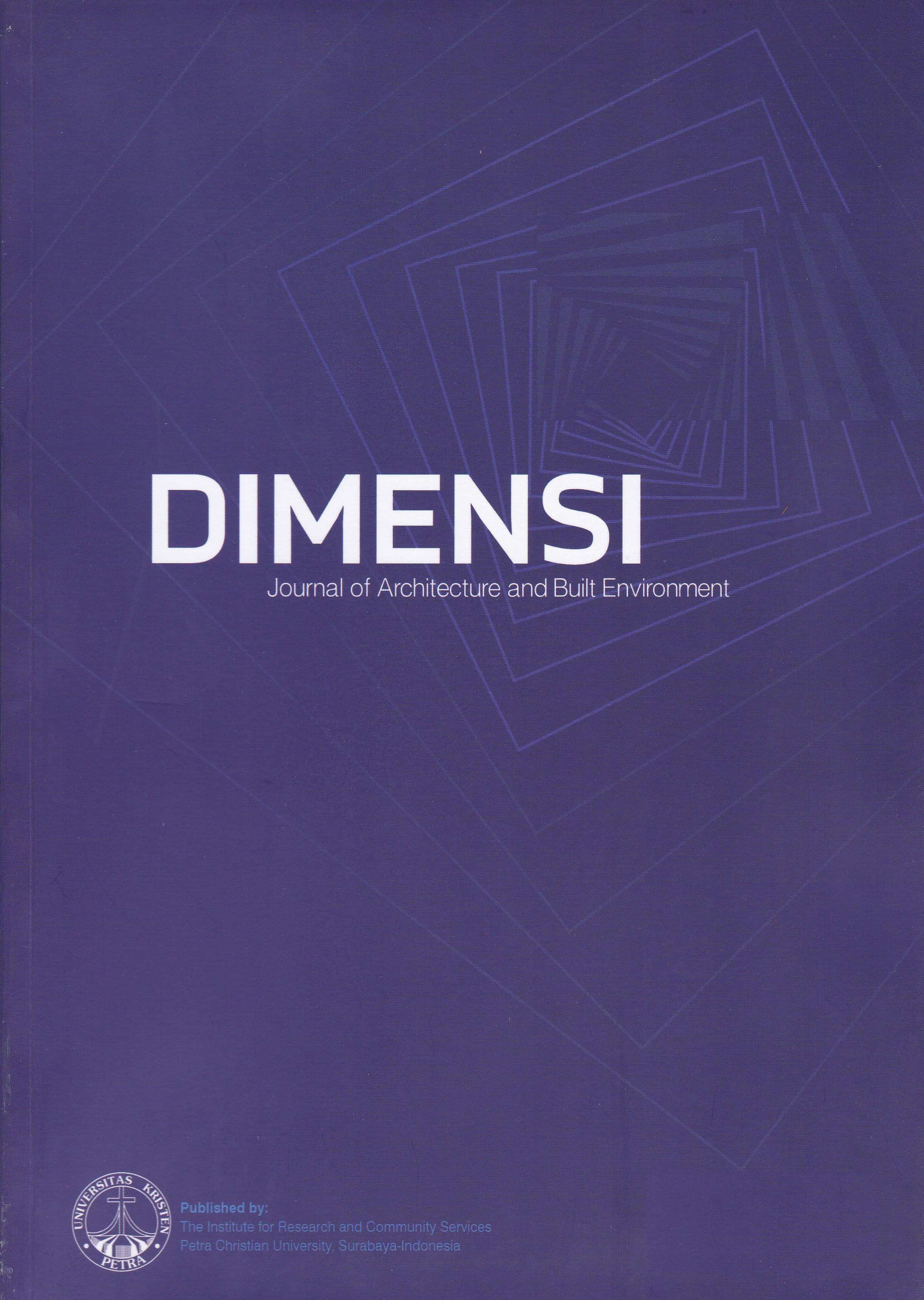OPTIMIZING SHADING DEVICES THROUGH THE SHADING EFFECT OF SURROUNDING BUILDINGS
DOI:
https://doi.org/10.9744/dimensi.46.2.79-86Keywords:
Thermal performance, surrounding buildings, Jakarta, shading devices, effective shadow angleAbstract
This study focuses on measuring the shading effect of surrounding buildings on the thermal performance of office buildings in Jakarta. It is compared with the shading effect of shading devices to optimize its use. This study uses EnergyPlus program to simulate a hypothetical 3x3block. The results showed that the H/W ratio has greater influence on building thermal performance than the surrounding building envelopes. With H/W ratio 2,7, the shading effect of surrounding buildings will be equivalent to 1,2m shading with an effective shadow angle of more than 360. For example, in a 10 floor building, the use of 1,2m shading is not required until the 8th floor based on the shadow angle in H/W ratio 2,7. At a smaller angle, the shading effect of surrounding buildings will be equal to the shading effect of shading devices with a width of less than 1,2m.Downloads
References
Allegrini, J., Dorer, V. & Carmeliet, J. (2015). Influence of morphologies on the microclimate in urban neighbourhoods, J. Wind Eng.Ind.Aerodyn.144, p.108–117.
Andersen, J.S. & Sattrup, P. (2011). The urban canyon and building energy use: Urban density versus daylight and passive solar gains, Energy and Buildings 43, p.2011–2020.
Ascione, F., et al. (2013). Analysis and diagnosis of the energy performance of buildings and districts: Methodology, validation and development of Urban Energy Maps, Cities 35, p.270–283.
Granadeiro, V., Duarte, J.P., Correia, J.R. & Leal, V.M. (2013). Building envelope shape design in early stages of the design process: Integrating architectural design systems and energy simulation, Automation in Construction 32, p.196–209.
Hachem, C., Athienitis, A. & Fazio, P. (2012). Evaluation of energy supply and demand in solar neighborhood, Energy and Buildings 49, p.335–347.
Han, Y. & Taylor, J.E. (2015). Disaggregate Analysis of the Inter-Building Effect in a Dense Urban Environment, Energy Procedia 75, p.1348 – 1353.
Han, Y., Pisello, A.L. & Taylor, J.E. (2015). Toward mitigating urban heat island effects: Investigating the thermal-energy impact of bio-inspired retro-reflective building envelopes in dense urban settings, Energy and Buildings 102, p.380–389.
Kirimtat, A., Koyunbaba, B., Chatzikonstantinou, I. & Sariyildiz, S. (2016). Review of simulation modeling for shading devices in buildings, Renewable and Sustainable Energy Reviews 53, p.23-49.
Kwong, Q.J. & Ali, Y. (2011). A review of energy efficiency potentials in tropical buildings – Perspective of enclosed common areas, Renewable and Sustainable Energy Reviews 15, p.4548– 4553.
Lee, K.S., Lee, J.W. & Lee, J.S. (2016). Feasibility study on the relation between housing density and solar accessibility and potential uses, Renewable Energy 85, p.749-758.
Marique, A.F. & Reiter, S. (2014). A simplified framework to assess the feasibility of zero-energy at theneighbourhood/community scale, Energy and Buildings 82, p.114–122.
Samuelson, H., Claussnitzer, S., Goyal, A., Chen, Y. & Romo-Castillo, A. (2016). Parametric energy simulation in early design: High-rise residential buildings in urban contexts, Building and Environment 101, p.19-31.
Sanaieian, H., Tenpierik, M., Linden, K.V., Seraj, F.M. & Shemrani, S.M. (2014). Review of the Impact of Urban Block Form on Thermal Performance, Solar Access and Ventilation, Renewable and Sustainable Energy Reviews 38, p.551-560.
Saud, M.I. (2012). Pengaruh Konfigurasi Window to Wall Ratio, Solar Heat Gain Coefficient dan Orientasi Bangunan terhadap Kinerja Termal Selubung Bangunan, Yogyakarta: Universitas Gadjah Mada.
Shrader, H. & Sayyed, A. (2012). Financing Climate Change Mitigation in the Building Sector.
Srebric, J., Heidarinejad, M. & Liu, J. (2015). Building neighborhood emerging properties and their impacts on multi-scale modeling of building energy and airflows, Building and Environment 91, p.246-262.
Steiner, F.R. & Butler, K. (2007). Planing and Urban Design Standards, New Jersey: John Wiley & Sons, Inc.
Downloads
Published
How to Cite
Issue
Section
License
Authors who publish with this journal agree to the following terms:
- Authors retain copyright and grant the journal right of first publication with the work simultaneously licensed under a Creative Commons Attribution License that allows others to share the work with an acknowledgement of the work's authorship and initial publication in this journal.
- Authors are able to enter into separate, additional contractual arrangements for the non-exclusive distribution of the journal's published version of the work (e.g., post it to an institutional repository or publish it in a book), with an acknowledgement of its initial publication in this journal.
- Authors are permitted and encouraged to post their work online (e.g., in institutional repositories or on their website) prior to and during the submission process, as it can lead to productive exchanges, as well as earlier and greater citation of published work (See The Effect of Open Access).



















